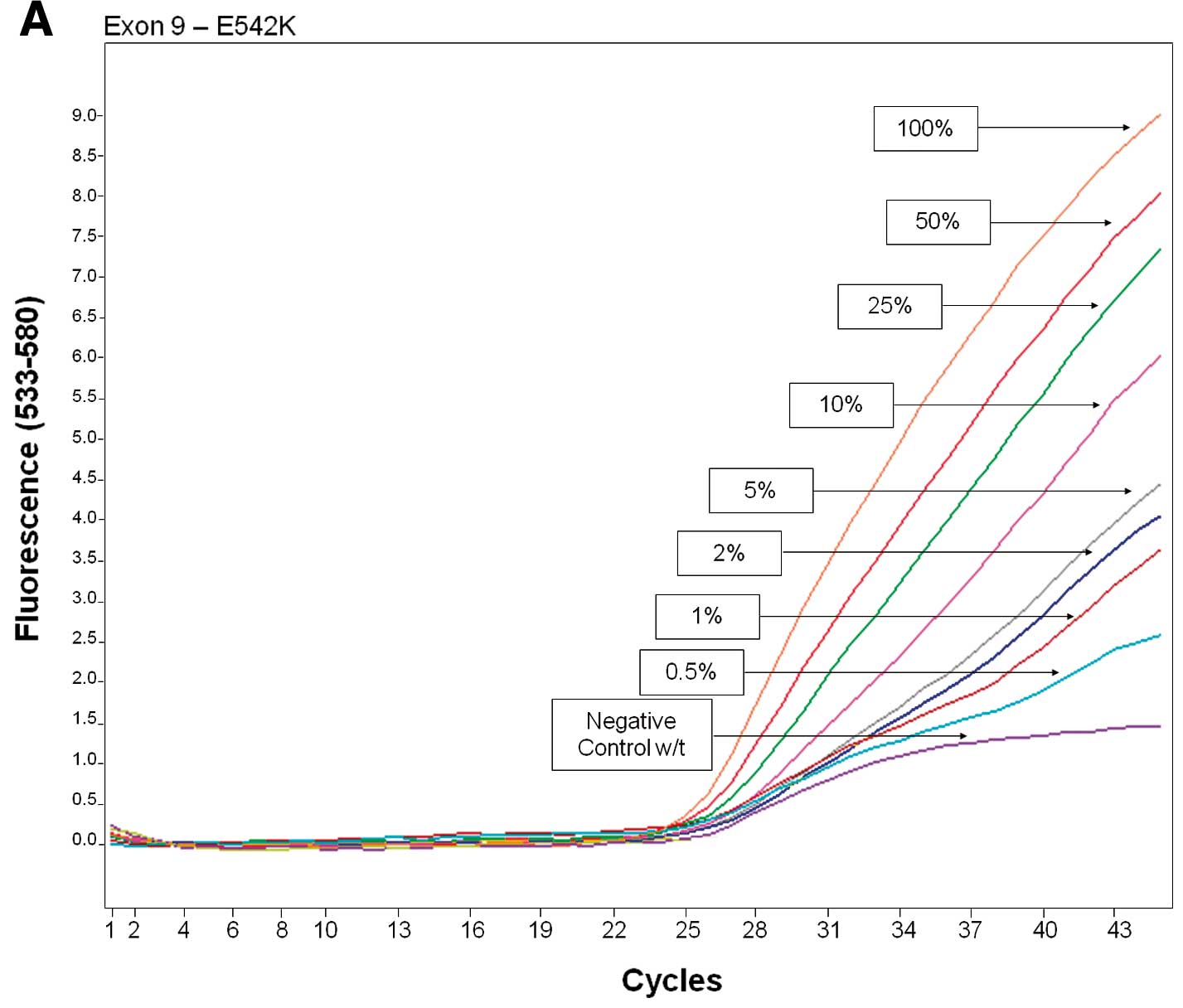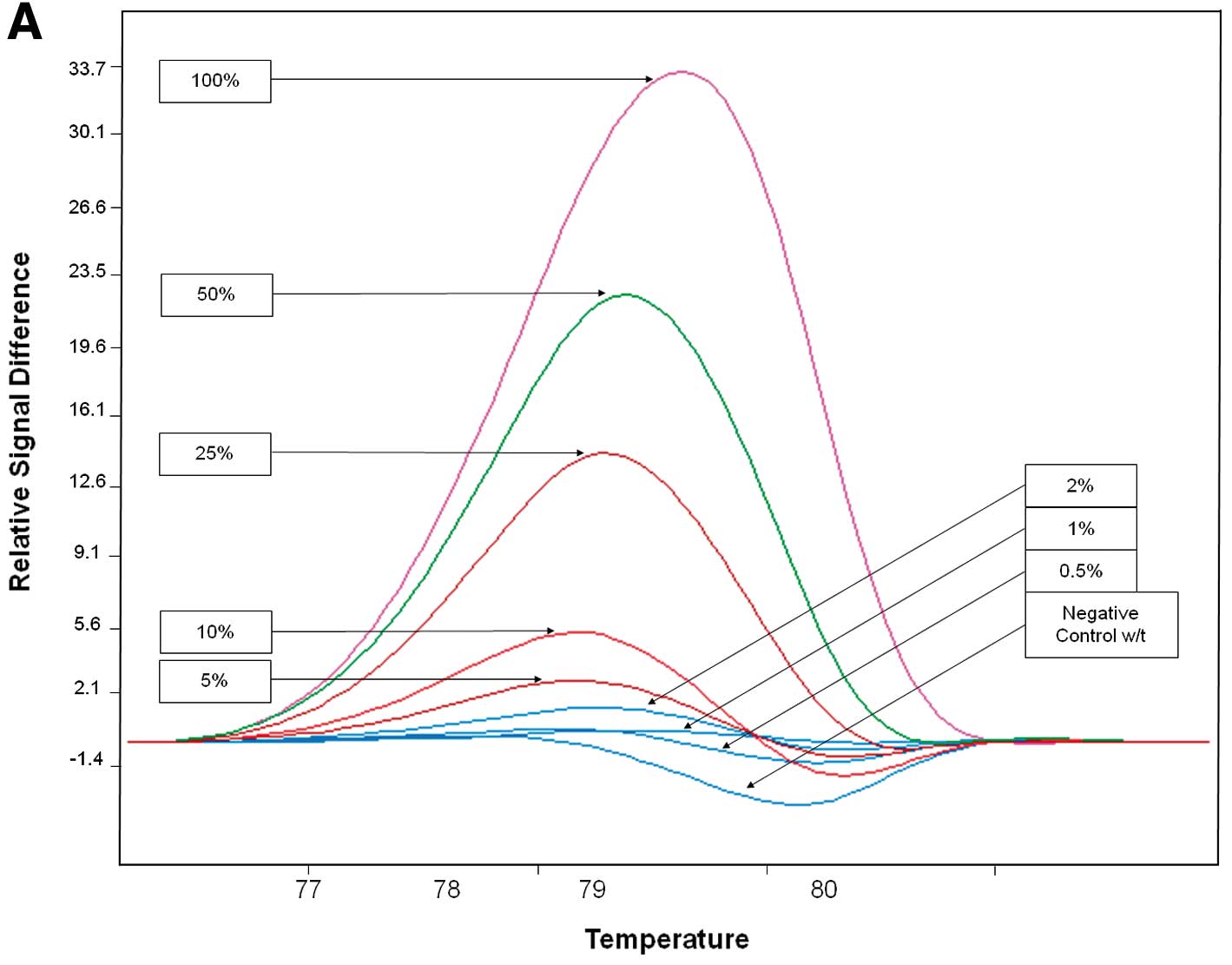|
1
|
Jemal A, Bray F, Center MM, Ferlay J, Ward
E and Forman D: Global cancer statistics. CA Cancer J Clin.
61:69–90. 2011. View Article : Google Scholar
|
|
2
|
Engelman JA, Luo J and Cantley LC: The
evolution of phosphatidylinositol 3-kinases as regulators of growth
and metabolism. Nat Rev Genet. 7:606–619. 2006. View Article : Google Scholar : PubMed/NCBI
|
|
3
|
Tokunaga E, Oki E, Egashira A, et al:
Deregulation of the Akt pathway in human cancer. Curr Cancer Drug
Targets. 8:27–36. 2008. View Article : Google Scholar : PubMed/NCBI
|
|
4
|
McAuliffe PF, Meric-Bernstam F, Mills GB
and Gonzalez-Angulo AM: Deciphering the role of PI3K/Akt/mTOR
pathway in breast cancer biology and pathogenesis. Clin Breast
Cancer. 10:S59–S65. 2010. View Article : Google Scholar : PubMed/NCBI
|
|
5
|
Wang L, Zhang Q, Zhang J, et al: PI3K
pathway activation results in low efficacy of both trastuzumab and
lapatinib. BMC Cancer. 11:2482011. View Article : Google Scholar : PubMed/NCBI
|
|
6
|
Jiang BH and Liu LZ: PI3K/PTEN signaling
in angiogenesis and tumorigenesis. Adv Cancer Res. 102:19–65. 2009.
View Article : Google Scholar : PubMed/NCBI
|
|
7
|
Bachman KE, Argani P, Samuels Y, et al:
The PIK3CA gene is mutated with high frequency in human breast
cancers. Cancer Biol Ther. 3:772–775. 2004. View Article : Google Scholar : PubMed/NCBI
|
|
8
|
Karakas B, Bachman KE and Park BH:
Mutation of the PIK3CA oncogene in human cancers. Br J Cancer.
94:455–459. 2006. View Article : Google Scholar : PubMed/NCBI
|
|
9
|
Dunlap J, Le C, Shukla A, et al:
Phosphatidylinositol-3-kinase and AKT1 mutations occur early in
breast carcinoma. Breast Cancer Res Treat. 120:409–418. 2009.
View Article : Google Scholar : PubMed/NCBI
|
|
10
|
Orlando L, Schiavone P, Fedele P, et al:
Molecularly targeted endocrine therapies for breast cancer. Cancer
Treat Rev. 36:S67–S71. 2010. View Article : Google Scholar : PubMed/NCBI
|
|
11
|
Miller TW, Balko JM and Arteaga CL:
Phosphatidylinositol 3-kinase and antiestrogen resistance in breast
cancer. J Clin Oncol. 29:4452–4461. 2011. View Article : Google Scholar : PubMed/NCBI
|
|
12
|
Abramson V and Arteaga CL: New strategies
in HER2-overexpressing breast cancer: many combinations of targeted
drugs available. Clin Cancer Res. 17:952–958. 2011. View Article : Google Scholar : PubMed/NCBI
|
|
13
|
Ma CX, Crowder RJ and Ellis MJ: Importance
of PI3-kinase pathway in response/resistance to aromatase
inhibitors. Steroids. 76:750–752. 2011. View Article : Google Scholar : PubMed/NCBI
|
|
14
|
Razis E, Bobos M, Kotoula V, et al:
Evaluation of the association of PIK3CA mutations and PTEN loss
with efficacy of trastuzumab therapy in metastatic breast cancer.
Breast. 128:447–456. 2011.PubMed/NCBI
|
|
15
|
Dave B, Migliaccio I, Gutierrez MC, et al:
Loss of phosphatase and tensin homolog or phosphoinositol-3 kinase
activation and response to trastuzumab or lapatinib in human
epidermal growth factor receptor 2-overexpressing locally advanced
breast cancers. J Clin Oncol. 29:166–173. 2011. View Article : Google Scholar
|
|
16
|
Esteva FJ, Guo H, Zhang S, et al: PTEN,
PIK3CA, p-AKT, and p-p70S6K status: association with trastuzumab
response and survival in patients with HER2-positive metastatic
breast cancer. Am J Pathol. 177:1647–1656. 2010. View Article : Google Scholar : PubMed/NCBI
|
|
17
|
Baselga J: Treatment of
HER2-overexpressing breast cancer. Ann Oncol. 21:vii36–40.
2011.
|
|
18
|
Garrett JT and Arteaga CL: Resistance to
HER2-directed antibodies and tyrosine kinase inhibitors: mechanisms
and clinical implications. Cancer Biol Ther. 11:793–800. 2011.
View Article : Google Scholar : PubMed/NCBI
|
|
19
|
Tanaka H, Yoshida M, Tanimura H, et al:
The selective class I PI3K inhibitor CH5132799 targets human
cancers harboring oncogenic PIK3CA mutations. Clin Cancer Res.
17:3272–3281. 2011. View Article : Google Scholar : PubMed/NCBI
|
|
20
|
Dan S, Okamura M, Mukai Y, et al: ZSTK474,
a specific phosphatidylinositol 3-kinase inhibitor, induces G1
arrest of the cell cycle in vivo. Eur J Cancer. 48:936–943. 2012.
View Article : Google Scholar : PubMed/NCBI
|
|
21
|
Bibeau F, Frugier H, Denouel A, Sabourin
JC and Boissiere-Michot F: Technical considerations for KRAS
testing in colorectal cancer. The pathologist’s point of view. Bull
Cancer. 96:S15–S22. 2009.(In French).
|
|
22
|
Vorkas PA, Poumpouridou N, Agelaki S,
Kroupis C, Georgoulias V and Lianidou ES: PIK3CA hotspot mutation
scanning by a novel and highly sensitive high-resolution small
amplicon melting analysis method. J Mol Diagn. 12:697–704. 2010.
View Article : Google Scholar : PubMed/NCBI
|
|
23
|
Board RE, Thelwell NJ, Ravetto PF, et al:
Multiplexed assays for detection of mutations in PIK3CA. Clin Chem.
54:757–760. 2008. View Article : Google Scholar : PubMed/NCBI
|
|
24
|
Dumont AG, Dumont SN and Trent JC: The
favorable impact of PIK3CA mutations on survival: an analysis of
2587 patients with breast cancer. Chin J Cancer. 31:327–334. 2012.
View Article : Google Scholar : PubMed/NCBI
|
|
25
|
Barbareschi M, Buttitta F, Felicioni L, et
al: Different prognostic roles of mutations in the helical and
kinase domains of the PIK3CA gene in breast carcinomas. Clin Cancer
Res. 13:6064–6069. 2007. View Article : Google Scholar : PubMed/NCBI
|
|
26
|
Lai YL, Mau BL, Cheng WH, Chen HM, Chiu HH
and Tzen CY: PIK3CA exon 20 mutation is independently associated
with a poor prognosis in breast cancer patients. Ann Surg Oncol.
15:1064–1069. 2008. View Article : Google Scholar : PubMed/NCBI
|
|
27
|
Lerma E, Catasus L, Gallardo A, et al:
Exon 20 PIK3CA mutations decrease survival in aggressive (HER-2
positive) breast carcinomas. Virchows Arch. 453:133–139. 2008.
View Article : Google Scholar : PubMed/NCBI
|
|
28
|
Cizkova M, Susini A, Vacher S, et al:
PIK3CA mutation impact on survival in breast cancer patients and in
ERalpha, PR and ERBB2-based subgroups. Breast Cancer Res.
14:R282012. View Article : Google Scholar : PubMed/NCBI
|
|
29
|
Aleskandarany MA, Rakha EA, Ahmed MA, et
al: PIK3CA expression in invasive breast cancer: a biomarker of
poor prognosis. Breast Cancer Res Treat. 122:45–53. 2009.
View Article : Google Scholar : PubMed/NCBI
|
|
30
|
Campbell IG, Russell SE, Choong DY, et al:
Mutation of the PIK3CA gene in ovarian and breast cancer. Cancer
Res. 64:7678–7681. 2004. View Article : Google Scholar : PubMed/NCBI
|
|
31
|
Levine DA, Bogomolniy F, Yee CJ, et al:
Frequent mutation of the PIK3CA gene in ovarian and breast cancers.
Clin Cancer Res. 11:2875–2878. 2005. View Article : Google Scholar : PubMed/NCBI
|
|
32
|
Miron A, Varadi M, Carrasco D, et al:
PIK3CA mutations in in situ and invasive breast carcinomas. Cancer
Res. 70:5674–5678. 2010. View Article : Google Scholar : PubMed/NCBI
|
|
33
|
Wu G, Xing M, Mambo E, et al: Somatic
mutation and gain of copy number of PIK3CA in human breast cancer.
Breast Cancer Res. 7:R609–R616. 2005. View Article : Google Scholar : PubMed/NCBI
|
|
34
|
Kalinsky K, Jacks LM, Heguy A, et al:
PIK3CA mutation associates with improved outcome in breast cancer.
Clin Cancer Res. 15:5049–5059. 2009. View Article : Google Scholar : PubMed/NCBI
|
|
35
|
Maruyama N, Miyoshi Y, Taguchi T, Tamaki
Y, Monden M and Noguchi S: Clinicopathologic analysis of breast
cancers with PIK3CA mutations in Japanese women. Clin Cancer Res.
13:408–414. 2007. View Article : Google Scholar : PubMed/NCBI
|
|
36
|
Ellis MJ, Lin L, Crowder R, et al:
Phosphatidyl-inositol-3-kinase alpha catalytic subunit mutation and
response to neoadjuvant endocrine therapy for estrogen receptor
positive breast cancer. Breast Cancer Res Treat. 119:379–390. 2010.
View Article : Google Scholar
|
|
37
|
Perez-Tenorio G, Alkhori L, Olsson B, et
al: PIK3CA mutations and PTEN loss correlate with similar
prognostic factors and are not mutually exclusive in breast cancer.
Clin Cancer Res. 13:3577–3584. 2007. View Article : Google Scholar : PubMed/NCBI
|
|
38
|
Baker CL, Vaughn CP and Samowitz WS: A
PIK3CA pyrosequencing-based assay that excludes pseudogene
interference. J Mol Diagn. 14:56–60. 2012. View Article : Google Scholar : PubMed/NCBI
|
|
39
|
Tougeron D, Lecomte T, Pages JC, et al:
Effect of low-frequency KRAS mutations on the response to anti-EGFR
therapy in metastatic colorectal cancer. J Clin Oncol.
30:35202012.PubMed/NCBI
|
















